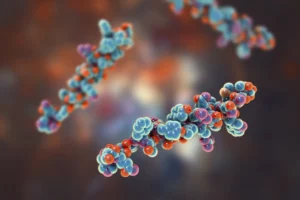Peptides have emerged as a cornerstone of biochemical research due to their versatility and specificity in interacting with various physiological processes. Ipamorelin and GHRP-2 (Growth Hormone Releasing Peptide-2) are two intriguing peptides whose combination has sparked considerable curiosity in scientific investigations. These compounds, classified as growth hormone secretagogues, have been studied for their potential to engage with specific receptors in research models to modulate endogenous processes. This article delves into the potential properties of an Ipamorelin and GHRP-2 peptide blend, emphasizing its possible implications in experimental research.
Understanding Ipamorelin and GHRP-2
Ipamorelin is a pentapeptide that has garnered attention for its selectivity and specificity. It is theorized to act by binding to the ghrelin receptor, also referred to as the growth hormone secretagogue receptor (GHS-R1a). Through this interaction, Ipamorelin seems to influence the release of growth hormone (GH) from the anterior pituitary, suggesting its potential role in modulating growth and metabolism-related pathways in research models.
GHRP-2, a hexapeptide, shares functional similarities with Ipamorelin but is hypothesized to possess a broader range of impacts due to its slightly different molecular structure. Studies suggest that GHRP-2 may also target GHS-R1a, potentially promoting the secretion of growth hormone and influencing other signaling cascades associated with this receptor. Its interaction with secondary pathways has been proposed, further extending its theoretically relevant implications when exploring diverse physiological systems.
Mechanisms of Action: Synergistic Potential
Ipamorelin’s high receptor selectivity suggests that it might have a focused impact on GH release without significantly engaging other endocrine pathways. This specificity is particularly helpful in research contexts where a targeted approach is necessary to evaluate isolated physiological mechanisms. GHRP-2, on the other hand, is believed to engage both direct and indirect pathways, potentially supporting GH release while influencing other signaling networks, such as those associated with appetite regulation and energy homeostasis.
Research Domains and Hypothetical Implications
The speculative properties of the Ipamorelin and GHRP-2 peptide blend suggest various avenues of exploration. Below are some domains where this combination may be employed to support scientific understanding:
- Metabolic Studies
Investigations have theorized that peptides targeting GH pathways may influence metabolic processes, including glucose utilization, lipid metabolism, and energy balance. Research indicates that the Ipamorelin and GHRP-2 blend may potentially serve as a tool to probe how GH secretion impacts these pathways in research models. For instance, the blend is thought to assist in studying metabolic adaptations during caloric surplus or deficit conditions, providing insights into energy homeostasis mechanisms.
- Muscular Tissue Research
It is hypothesized that GH secretagogues might play a role in tissue repair and regeneration, particularly in skeletal muscle. Investigations purport that the peptide blend may stimulate GH release and provide a model for exploring the cellular mechanisms underlying protein synthesis and muscular tissue recovery. Additionally, researchers might expose research models to this blend to examine its possible impacts on satellite cell activation and myogenesis in controlled experimental settings.
- Neuroendocrine Research
The ghrelin receptor, believed to be targeted by both Ipamorelin and GHRP-2, is also expressed in various regions of the brain. This opens potential research pathways into neuroendocrine signaling and the hypothalamic-pituitary axis. Findings imply that the blend might help elucidate how GH pathways are integrated with other hormonal systems, contributing to a deeper understanding of the intricate feedback loops.
- Cellular Aging and Cellular Senescence
The role of GH in cellular aging processes is a topic of significant interest. Scientists speculate that utilizing Ipamorelin and GHRP-2 in experimental settings may allow researchers to explore how GH release correlates with markers of cellular aging and cellular senescence. This peptide combination has been hypothesized to serve as a model to investigate mechanisms such as telomere maintenance, oxidative stress regulation, and mitochondrial function in cellular aging-related studies.
- Exploring Anabolic Pathways
Anabolic processes are critical for maintaining tissue integrity and function. Studies postulate that the peptide blend may be utilized to explore how GH interacts with anabolic signaling cascades, such as those involving insulin-like growth factor 1 (IGF-1). By understanding these pathways, researchers may hypothesize about potential implications in fields like tissue engineering and regenerative science.
- Immune System Research
GH pathways are thought to influence immune responses, potentially modulating inflammatory and anti-inflammatory signaling. It has been proposed that the Ipamorelin and GHRP-2 blend might provide a framework for investigating how immune cells respond to changes in GH levels, aiding in the study of immune system dynamics during stress, injury, or infection.
Properties in Research Contexts
The hypothesized properties of Ipamorelin and GHRP-2 make their blend particularly appealing for controlled experimental studies. The high specificity of Ipamorelin, coupled with the broader impact profile of GHRP-2, seems to allow researchers to design nuanced experiments that probe both targeted and systemic phenomena. Furthermore, the blend’s interaction with well-characterized receptors like GHS-R1a appears to facilitate a deeper understanding of receptor-ligand dynamics, aiding in the development of receptor-targeted research models.
Future Directions and Conclusion
The Ipamorelin and GHRP-2 peptide blend represents a promising tool for advancing research in multiple domains. Future investigations might focus on characterizing the specific signaling cascades influenced by this combination and identifying novel implications in emerging fields like synthetic biology and bioinformatics. Furthermore, integrating this blend into multi-omics approaches may reveal new insights into its impacts on gene expression, proteomics, and metabolomics. Click here: https://biotechpeptides.com/2024/12/12/ipamorelin-ghrp-2-blend-research-into-growth-hormone-secretion/ for more information about this blend.
References
[i] Jönsson, A. H., & Zhang, Z. (2012). The role of growth hormone in immune function and inflammation. Journal of Immunology, 189(3), 903–909. https://doi.org/10.4049/jimmunol.1200288 [ii] Walker, R. F., & Walker, B. B. (2014). Growth hormone, aging, and age-related diseases. Frontiers in Endocrinology, 5, Article 13. https://doi.org/10.3389/fendo.2014.00013 [iii] Nass, R., Pezzoli, S. S., Oliveri, M. C., Patrie, J. T., Harrell, F. E., Clasey, J. L., & Thorner, M. O. (2008). Effects of an oral ghrelin mimetic on body composition and clinical outcomes in healthy older adults: A randomized trial. Annals of Internal Medicine, 149(9), 601–611. https://doi.org/10.7326/0003-4819-149-9-200811040-00005 [iv] Smith, R. G., Jiang, H., Sun, Y., & Albarrán-Zeckler, R. (2008). Ghrelin receptor (GHS-R1a) agonists show potential in treatment for metabolic dysfunctions. Nature Clinical Practice Endocrinology & Metabolism, 4(11), 630–638. https://doi.org/10.1038/ncpendmet0983 [v] Bowers, C. Y., Momany, F. A., Reynolds, G. A., & Hong, A. (1984). On the in vitro and in vivo activity of a synthetic hexapeptide that acts on the pituitary to specifically release growth hormone. Endocrinology, 114(5), 1537–1545. https://doi.org/10.1210/endo-114-5-1537






